Planets/Classicals/Aion
< Planets < Classicals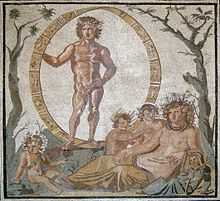
Aion is an apparent deity seen by cultures north of Earth's equator.
Time deity

"Aion (Greek Αἰών) is a Hellenistic deity associated with time, the orb or circle encompassing the universe, and the zodiac. The "time" represented by Aion is unbounded, in contrast to Chronos as empirical time divided into past, present, and future.[1] He is thus a god of eternity, associated with mystery religions concerned with the afterlife, such as the mysteries of Cybele, Dionysus, Orpheus, and Mithras. In Latin the concept of the deity may appear as Aevum or Saeculum.[2] He is typically in the company of an earth or mother goddess such as Tellus or Cybele, as on the Parabiago plate.[3]"[4] The picture at page right top is of Aion-Uranus.
"The snake could be a symbol of time and an element of Saturn's iconography and is associated with the snake shown coiled around the Aion deity (Beck, 1984, 2087)."[5]
Mandulis Aion
"The Roman garrison town of Talmis, now called Kalabsha, lies in Nubia a little South of the Lesser Cataracts of the Nile and was the seat of a god called Merul or Melul, a name hellenized as Mandulis. He was worshipped elsewhere in this region, as for instance in a temple of his own at Ajuala and in the temple of Petêsi and Pihor at Dendûr, and again further North at Philae, where a figure of him was in A.D. 394 sculptured on the North wall of the ‘Hadrian passage,’ but he is at Dendûr described as ‘great god, lord of Talmis,’ and Talmis was certainly the center of his cult."[6]
"He was probably a solar deity, and was commonly associated with Isis, who had a dominant position in this region.7 She takes precedence over him, as does also Osiris, in his occasional appearances in the temple reliefs."[6]
Two suns
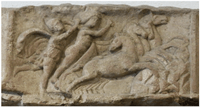
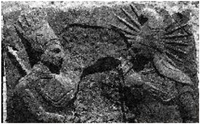
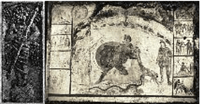
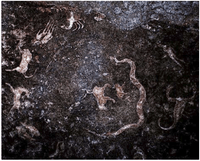
"The relationship between Mithras and the sun is a constant of Mithraic imagery. In the central panels of the mithraeum depicting the tauroctony we see how Mithras turns his attention from the main event of sacrificing the bull to gaze at the sun in anthropomorphic form, which returns his gaze, always accompanied by the raven, his sacred animal."[5]
"It is in the scenes of Mithras’ life depicted in the panels surrounding the mithraeum’s tauroctony that we can see the sequence of the relationship between Mithras and the sun, as Helios. First there is a scene showing Helios’ submission. For example, in the Roman mithraeum of Barberini (CIMRM 390) Mithras is shown standing on the right-hand side of the lower scene, placing a crown on the sun, which is kneeling."[5]
"The banqueting scene that follows the one described above is more common. In all cases the two deities are depicted as equals, showing that there is true communion between them. In the relief from Alba Iulia (CIMRM 1958) the two deities appear on a triclinium. After the banquet, Mithras is portrayed [in the top image on the right] climbing onto the chariot driven by Helios."[5]
"We find representations in which Mithras is identified with the sun, although there is a clear differentiation between him, Helios and Sol. The oldest representations are from an Iranian context, as is the case of the orthostat at the Nemrut Dagi funeral sanctuary in Commagene, where Antiochus I (324-261) extends his hand to Mithras [in the second image down on the right], who is surround[ed] by the sun’s rays on his Phrygian cap (Silloti, 2006, 21). This identification with the sun is less common in Roman Mithraic scenes. It can be seen on a bronze brooch from Ostia (CIMRM 318) depicting Mithras wearing a Phrygian cap surrounded by a halo and a great crown of nine rays."[5]
"The clearest identification of Mithras with the sun is found in the many inscriptions that refer to him as Soli Invicto (Halsbergue, 1972, 79). Thus Mithras is a different solar deity from Helios."[5]
"David Ulansey (1994) puts forward an interesting hypothesis in his work Mithras and the Hypercosmic Sun, in which he identifies Mithras’ role as the “unconquered sun”, a different solar deity from Helios. This interpretation is supported by the philosophical theories of the Neoplatonists."[5]
"In Book VI of the Republic, Plato (427-347 BCE) describes the sun as the source of all enlightenment and understanding of everything that exists in the visible world. He amplifies this image in Book VII with the metaphor of the myth of the caves, in which he likens normal human life to living in a cave."[5]
"Plato complemented this myth in Phaedrus, in which he makes the destination of immortal souls a realm beyond the heavens (Hackforth, 1952)."[5]
"The prolific philosopher Philo (15/10 BCE - 45/50 BCE) later developed the concept of “hypercosmic sun” in a passage from De Opificio Mundi. The existence of two suns was still being defended by Julian in the Chaldaean Oracles of the second century where, in certain unnamed mysteries, it was taught that “the sun travels in the starless heavens far above the region of the fixed stars” (Lewy, 1978)."[5]
"In view of these testimonies David Ulansey defends a striking parallel with the Mithraic evidence, in which we also find two suns, one being Helios the sun-god (who is always distinguished from Mithras in the iconography) and the other being Mithras in his role as the “unconquered sun”. He reiterates this proposal in his article ‘The Eighth Gate: The Mithraic Lion-Headed Figure and the Platonic World-Soul’, in which he analyses the central scene of the Barberini mithraeum (CIMRM 390). The tauroctony appears under an arch formed by the signs of the zodiac. Above the arch there are a number of fires separated by trees. There is also a figure with a snake coiled around it; this figure links the two layers and stands on a globe located in the middle of the zodiac while his body penetrates into the upper level. The head, unseen, is at the height of the fires [third image down on the right]. This is the Aion figure that stands on the cosmic sphere holding a key in his right hand (CIMRM 543) or with the zodiac inscribed on his body (CIMRM 879). Its position in the Barberini zodiac is explained, according to Ulansey, by Origen (185-254) in his work Contra Celsum. Celsus describes a Mithraic symbol consisting of a ladder with seven gates, each associated with one of the seven planets, while at the top there is an eighth gate associated with the sphere of the fixed stars leading to the region beyond that sphere (Chadwik, 1953, VI:22)."[5]
"We now have the complete iconographic reading, where Mithras ascends on Helios’ chariot to the limit of the sphere of the fixed stars which he alone is capable of penetrating; he becomes the Aion figure in order to reach the fiery sphere referred to by Greek philosophers such as Parmenides and Anaxagoras. The fiery sphere would equate with the “hypercosmic sun” and even survives in Catholic theology as “Empyrean”, the highest heaven or Paradise, the abode of God [in the last image down on the right] and the celestial beings described in Dante’s Divine Comedy (Dante, 1876, 193)."[5]
Prehistory
The prehistory period dates from around 7 x 106 b2k to about 7,000 b2k.
Paleolithic
The paleolithic period dates from around 2.6 x 106 b2k to the end of the Pleistocene around 12,000 b2k.
Mesolithic
The mesolithic period dates from around 13,000 to 8,500 b2k.
Ancient history
The ancient history period dates from around 8,000 to 3,000 b2k.
Early history
The early history period dates from around 3,000 to 2,000 b2k.
Time associated with Aion during the early Helenistic period around 2300 b2k is unbounded or seasonal, an ever repeating cycle, rather than past, present, and future.[1]
"Son schéma de composition, ä abord, renvoie à des antécédents africains du lIe s. ; et les attributs d' Aïon (en particulier les fruits) évoquent Ie dieu régional Saeculum Frugiferum, d' ailleurs aussi représenté souvent comme maître du Cosmos. Associé au zodiaque et point focal du groupe des Saisons avec leurs symboles, Aïon/Annus personnifze I' année prolifique et, par-delà, Ie cycle infini du temps avec Ie renouvellement perpétuel de la nature, gage de prospérité universelle."[7] Here, Aion is often depicted as master of the Cosmos. It is associated with the zodiac and the focal point of the seasons. Aion/Annus personalize a prolific year and beyond; i.e., an endless cycle of time with a perpetual renewal of nature and a universal guarantee of prosperity.
"Aion apparently played a role in the Eleusinian mysteries, as evidenced by a dedicatory inscription on the base of a statue dated to the first century BCE at the Koreion.13"[8]
Classical history
The classical history period dates from around 2,000 to 1,000 b2k.
"A more significant difference, however, between the known type and the new variant is the Greek inscription appearing in the exergue, partly visible only on the coins of Gordianus III [around 251-3, or 1749-1747 b2k]. The inscription reads AIωN, the ancient allegory of ‘eternal time.’3"[8]
"Nonnus [sometime between 1700-1600 b2k] compared Aion to a serpent when he wrote: “... he (Aion) would put off the burden of age, like a snake throwing off the rope-like slough of his feeble old scales, and grow young again bathed in the waves of Law” (Dion. 41:180–184)."[8]
Both Aion (Ouranus and Chronos) are described as having rings around them like Saturn of today. This suggests that one Aion transformed into the next Chronos.
"In his description about the origin of the Universe, Eusebius (Praep. evang. 1:10.7) describes Aion as a mortal, born from the wind Kolpias and his wife Baaut (Nyx, the night) and brother of Protogonos (Eros/Phanes)."[8]
"Eusebius [about 1740-1660 b2k] further explains that Aion discovered the nourishment of the flora and was father of Genos and Genea who would dwell in Phoenicia. From the race of Aion and Protogonos, the mortal infants Phos (Light), Pyr (Fire) and Phlox (flame) were born, who invented fire (Levi 1944:278). Being the son of a Wind, Aion was invoked as god of the four winds in magical texts and was also associated with the Seasons (Levi 1944:296)."[8]
"According to an Egyptian tradition, Aion was identified with Serapis, the god of the dead, appearing in an image encircled by a serpent (Cumont 1899:79 and n. 8; Pettazzoni 1954a). This assimilation with the Egyptian god might also be related to a festival in Alexandria that took place on the night of January 5th, where an image of Aion was carried at the Koreion, in order to celebrate his birth from Kore. This rite is described by Epiphanius [c. 1690–1680 – 1597 b2k] (Panarion, 51:22, 3–11).14"[8]
"Based on the same passage in Epiphanius, Pettazzoni focused attention on another pagan festival, called the Kronia, the birthday feast of Chronos (as sun), which fell on December 25th, coinciding with the winter solstice. For Pettazzoni both Aion and Chronos are two different representations of an ancient conception of endless Time that derive ultimately from a sun-god (1954a:172–176).15"[8]
"Following his description of the birth of Aion in Alexandria, Epiphanius writes about the birth of Dushara in Petra and Elusa.16 Based on this text, Patrich established a connection between the allegory of Aion and the god Dionysus, through his Nabatean assimilation Dushara (Patrich 2005). He further suggested an association between Aion/Dushara (Dousares) with the emperor’s cult and Roman eternity [...]."[8]
"The many difficulties, presented above, in understanding Aion were summarized well by Guthrie: “... it is likely that Orphism from an early date owed much to the Persian worship of Zervân (Aion to the Greeks), in the form of an assimilation to him either of their own Chronos or of Phanes-Dionysus” (Guthrie 1935:228)."[8]
Recent history
The recent history period dates from around 1,000 b2k to present.
Research
Hypothesis:
- All versions of Aion are Ouranus the original binary stellar companion of the Sun.
- What is left of Aion includes Uranus.
Control groups

The findings demonstrate a statistically systematic change from the status quo or the control group.
“In the design of experiments, treatments [or special properties or characteristics] are applied to [or observed in] experimental units in the treatment group(s).[9] In comparative experiments, members of the complementary group, the control group, receive either no treatment or a standard treatment.[10]"[11]
Proof of concept
Def. a “short and/or incomplete realization of a certain method or idea to demonstrate its feasibility"[12] is called a proof of concept.
Def. evidence that demonstrates that a concept is possible is called proof of concept.
The proof-of-concept structure consists of
- background,
- procedures,
- findings, and
- interpretation.[13]
See also
References
- 1 2 Doro Levi, "Aion," Hesperia 13.4 (1944), p. 274.
- ↑ Levi, "Aion," p. 274.
- ↑ Levi, "Aion," p.
- ↑ "Aion (deity), In: Wikipedia". San Francisco, California: Wikimedia Foundation, Inc. January 6. 2013. Retrieved 2013-01-14.
- 1 2 3 4 5 6 7 8 9 10 11 12 M Pilar Burillo-Cuadrado and Francisco Burillo-Mozota (2014). "The Swastika as Representation of the Sun of Helios and Mithras". Mediterranean Archaeology and Archaeometry 14 (3): 29-36. http://maajournal.com/Issues/2014/Vol14-3/Full3.pdf. Retrieved 2015-05-20.
- 1 2 Arthur Darby Nock (January 1934). "A vision of Mandulis Aion". Harvard Theological Review 27 (01): 53-104. doi:10.1017/S0017816000021398. http://journals.cambridge.org/action/displayAbstract?fromPage=online&aid=7820516&fileId=S0017816000021398. Retrieved 2015-05-20.
- ↑ David Parrish (1995). "The mosaic of Aion and the seasons from Haïdra (Tunisia): an interpretation of its meaning and importance". Antiquité Tardive 3: 167-91. doi:10.1484/J.AT.2.301095. http://www.brepolsonline.net/doi/abs/10.1484/J.AT.2.301095?journalCode=at. Retrieved 2015-09-24.
- 1 2 3 4 5 6 7 8 9 Gabriela Bijovsky (February 2007). "AION: A Cosmic Allegory on a Coin from Tyre?". Israel Numismatic Research 2: 143-56. http://s3.amazonaws.com/academia.edu.documents/30897613/INR-2_Bijovsky_AION.pdf?AWSAccessKeyId=AKIAJ56TQJRTWSMTNPEA&Expires=1443126395&Signature=Wc3n5vaOl4JW%2BBAba6pVLaVWyYs%3D&response-content-disposition=inline. Retrieved 2015-09-26.
- ↑ Klaus Hinkelmann, Oscar Kempthorne (2008). Design and Analysis of Experiments, Volume I: Introduction to Experimental Design (2nd ed.). Wiley. ISBN 978-0-471-72756-9. http://books.google.com/?id=T3wWj2kVYZgC&printsec=frontcover.
- ↑ R. A. Bailey (2008). Design of comparative experiments. Cambridge University Press. ISBN 978-0-521-68357-9. http://www.cambridge.org/uk/catalogue/catalogue.asp?isbn=9780521683579.
- ↑ "Treatment and control groups, In: Wikipedia". San Francisco, California: Wikimedia Foundation, Inc. May 18, 2012. Retrieved 2012-05-31.
- ↑ "proof of concept, In: Wiktionary". San Francisco, California: Wikimedia Foundation, Inc. November 10, 2012. Retrieved 2013-01-13.
- ↑ Ginger Lehrman and Ian B Hogue, Sarah Palmer, Cheryl Jennings, Celsa A Spina, Ann Wiegand, Alan L Landay, Robert W Coombs, Douglas D Richman, John W Mellors, John M Coffin, Ronald J Bosch, David M Margolis (August 13, 2005). "Depletion of latent HIV-1 infection in vivo: a proof-of-concept study". Lancet 366 (9485): 549-55. doi:10.1016/S0140-6736(05)67098-5. http://www.ncbi.nlm.nih.gov/pmc/articles/PMC1894952/. Retrieved 2012-05-09.
External links
| |||||||||||||||||||||||||||||||||||||||||||||||||||||
| ||||||||||||||||||||||||||||||||||||||
![]() This is a research project at http://en.wikiversity.org
This is a research project at http://en.wikiversity.org
| |
Development status: this resource is experimental in nature. |
| |
Educational level: this is a research resource. |
| |
Resource type: this resource is an article. |
| |
Resource type: this resource contains a lecture or lecture notes. |
| |
Subject classification: this is an archaeology resource. |
| |
Subject classification: this is an astronomy resource. |
| |
Subject classification: this is a humanities resource. |